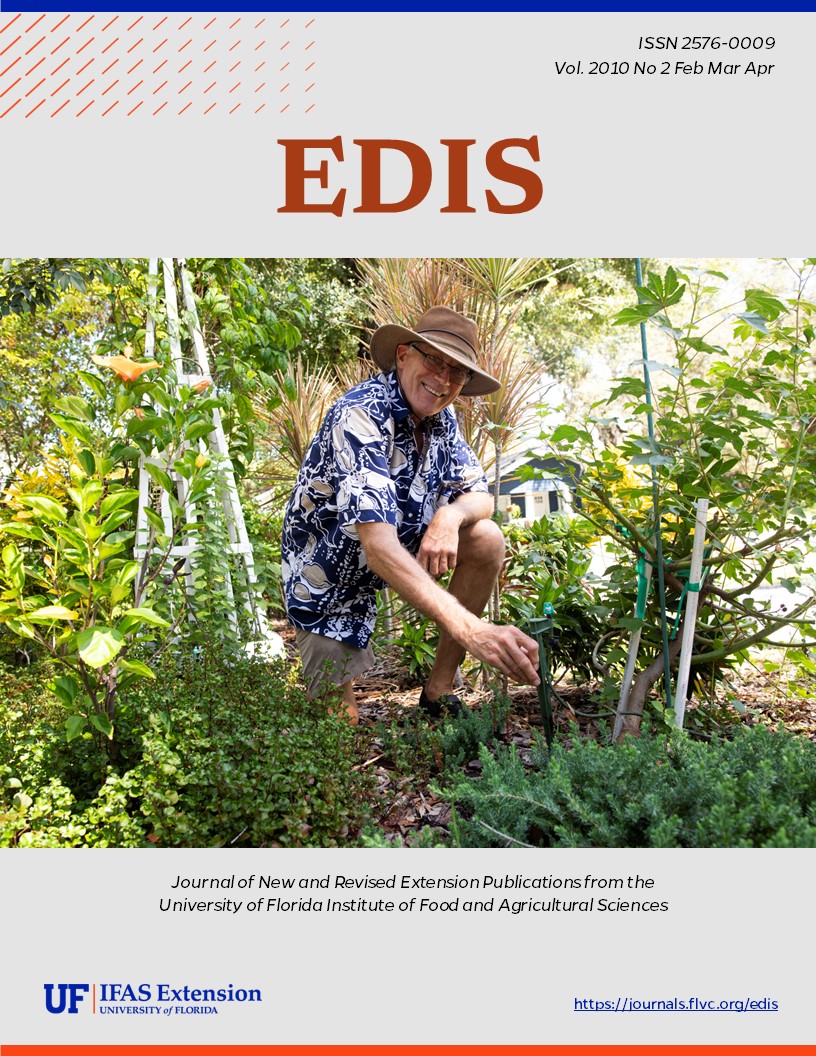Abstract
FA164, a 10-page illustrated fact sheet by Roy P. E. Yanong, describes this significant disease problem for marine aquarists and commercial mariculture worldwide — signs of disease, biology and life cycle, immunity, diagnostics, prevention and control, disinfection, and biosecurity considerations. Includes references. Published by the UF Program in Fisheries and Aquatic Sciences, December 2009.
FA164/FA164: Cryptocaryon irritans Infections (Marine White Spot Disease) in Fish (ufl.edu)
References
Bai, J.S., M.Q. Xie, X.Q. Zhu, X.M. Dan, and A.X. Li. 2008. Comparative studies on immunogenicity of theronts, tomonts and trophonts of Cryptocaryon irritan in grouper. Parasitol Res 102:307-313. https://doi.org/10.1007/s00436-007-0766-6
Burgess, P.J. 1992. Cryptocaryon irritan Brown, 1951 (Ciliophora): transmission and immune response in the mullet Chelon labrosus (Risso, 1826). Ph.D. thesis, University of Plymouth.
Burgess, P.J. and R.A. Matthews. 1995. Cryptocaryon irritans (Ciliophora): acquired protective immunity in the thick-lipped mullet, Chelon labrosus. Fish and Shellfish Immunology 5: 459-468. https://doi.org/10.1006/fsim.1995.0043
Cheung, P.J., R.F. Nigrelli, and G.D. Ruggieri. 1979. Studies on cryptocaryoniasis in marine fish: effect of temperature and salinity on the reproductive cycle of Cryptocaryon irritans Brown, 1951. Journal of Fish Diseases 2: 93-97. https://doi.org/10.1111/j.1365-2761.1979.tb00146.x
Colorni, A. 1985. Aspects of the biology of Cryptocaryon irritans, and hyposalinity as a control measure in cultured gilt-head sea bream Sparus aurata. Diseases of Aquatic Organisms 1: 19-22. https://doi.org/10.3354/dao001019
Colorni, A. 1987. Biology of Cryptocaryon irritans and strategies for its control Aquaculture 67: 236-237. https://doi.org/10.1016/0044-8486(87)90041-X
Colorni, A. and P. Burgess. 1997. Cryptocaryon irritans Brown 1951, the cause of "white spot disease" in marine fish: an update. Aquarium Sciences and Conservation, 1: 217-238. https://doi.org/10.1023/A:1018360323287
Dan, X.M., A.X. Li, X.T.Lin, N.Teng, and X.Q. Zhu. 2006. A standardized method to propagate Cryptocaryon irritans on a susceptible host pompano Trachinotus ovatus. Aquaculture 258: 127-133. https://doi.org/10.1016/j.aquaculture.2006.04.026
Dan, X.M., X.T. Lin, Y.X Yan, N. Teng, Z.L. Tan, and A.X. Li. 2009. A technique for the preservation of Cryptocaryon irritans at low temperatures. Aquaculture 297: 112-115. https://doi.org/10.1016/j.aquaculture.2009.10.001
De Boeck, G., T.T.H. Ngo, K. Van Campenhout, and R. Blust. 2003. Differential metallothionein induction patterns in three freshwater fish during sublethal copper exposure. Aquatic Toxicology 65; 413-424. https://doi.org/10.1016/S0166-445X(03)00178-4
Dickerson, H.W. 2006. Ichthyophthirius multifiliis and Cryptocaryon irritans (Phylum Ciliophora). Pages 116-153 In Woo, P.T.K., ed. Fish diseases and disorders vol.1: protozoan and metazoan disorders. 2nd ed. CAB International. Cambridge, MA. https://doi.org/10.1079/9780851990156.0116
Diggles, B.K. and R.D. Adlard. 1997. Intraspecific variation in Cyrptocaryon irritans. J. Euk. Microbiol. 44 (1): 25-32. https://doi.org/10.1111/j.1550-7408.1997.tb05686.x
Diggles, B.K. and R.J.G. Lester. 1996a. Infections of Cryptocaryon irritans on wild fish from southeast Queensland, Australia. Diseases of Aquatic Organisms 25: 159-167. https://doi.org/10.3354/dao025159
Diggles, B.K. and R.J.G. Lester. 1996b. Influence of Temperature and Host Species on the development of Cryptocaryon irritans. The Journal of Parasitology Vol. 82(1): 45-51. https://doi.org/10.2307/3284114
Diggles, B.K. and R.J.G. Lester. 1996c. Variation in the development of two isolates of Cryptocaryon irritans. The Journal of Parasitology Vol. 82 (3): 384-388. https://doi.org/10.2307/3284073
Francis-Floyd, R. 1996. Use of formalin to control fish parasites. VM-77. College of Veterinary Medicine, Florida Cooperative Extension Service, Institute of Food and Agricultural Sciences, University of Florida, Gainesville, FL. http://edis.ifas.ufl.edu/VM061 (Accessed November 12, 2009)
Francis-Floyd, R. and P. Reed. 2009. Ichthyophthirius multifiliis (white spot) infections in fish. CIR920. Program in Fisheries and Aquatic Sciences, SFRC, Florida Cooperative Extension Service, Institute of Food and Agricultural Sciences, University of Florida, Gainesville, FL. http://edis.ifas.ufl.edu/FA006 (accessed November 12, 2009)
Hatanaka, A., N. Umeda, S. Yamashita, and N. Hirazawa. 2007. Identification and characterization of a putative agglutination/immobilization antigen on the surface of Cryptocaryon irritans. Parasitology 134: 1163-1174. https://doi.org/10.1017/S003118200700265X
Hirazawa, N., T. Goto, and K. Shirasu. 2003. Killing effect of various treatments on the monogenean Heterobothrium okamotoi eggs and oncomiracidia and the ciliate Cryptocaryon irritans cysts and theronts. Aquaculture 223: 1-13. https://doi.org/10.1016/S0044-8486(03)00167-4
Hoff, F.H. 1996. Conditioning, spawning, and rearing of fish with emphasis on marine clownfish. Aquaculture Consultants, Inc., Dade City, FL. 212 pp.
Hoffman, G.L. 1974. Disinfection of contaminated water by ultraviolet irradiation, with emphasis on whirling disease (Mysoxosma cerebralis): and its effect on fish. Transactions of the American Fisheries Society 103: 541-550. https://doi.org/10.1577/1548-8659(1974)103<541:DOCWBU>2.0.CO;2
Luo, X.C., M.Q. Xie, X.Q. Zhu, and A.X. Li. 2008. Some characteristics of host-parasite relationship for Cryptocaryon irritans isolated from South China. Parasitology Research 102: 1269-1275.
https://doi.org/10.1007/s00436-008-0904-9
Noga, E.J. 1996. Fish disease: diagnosis and treatment. Mosby-Year Book, Inc., St. Louis, MO. 367 pp.
Roberts, H., B. Palmiero, and E.S.Weber III. 2009. In Bacterial and parasitic diseases of fish. Laura Wade, ed. Veterinary clinics of North America: exotic animal practice. 12 (3): 609-638. https://doi.org/10.1016/j.cvex.2009.06.010
Stoskopf, M.K. 1993. Fish medicine. W.B. Saunders, Philadelphia, PA. 992 pp.
Wilkie, D.W. and H. Gordin. 1969. Outbreak of cryptocaryoniasis in marine aquaria at Scripps Institution of Oceanography. California Fish and Game 55(3): 227-236.
Wooster, G.A., T.M. Bishop, and P.R. Bowser. 2001. The aerobiological dissemination of the fish parasite Ichthyophthirius multifiliis. Proceedings, 26th Eastern Fish Health Workshop. Leetown, WV.
Yambot, A.V., and Y.L. Song. 2006. Immunization of grouper, Epinephelus coioides, confers protection against a protozoan parasite, Cryptocaryon irritans. Aquaculture 260: 1-9. https://doi.org/10.1016/j.aquaculture.2006.05.055
Yambot, A.V., Y.L. Song, and H.H. Sung. 2003. Characterization of Cryptocaryon irritans, a parasite isolated from marine fishes in Taiwan. Diseases of Aquatic Organisms 54: 147-156. https://doi.org/10.3354/dao054147
Yanong, R.P.E. 2009. Fish health management considerations in recirculating aquaculture systems. Program in Fisheries and Aquatic Sciences, SFRC, Florida Cooperative Extension Service, Institute of Food and Agricultural Sciences, University of Florida, Gainesville, FL. http://edis.ifas.ufl.edu/FA100 (accessed November 12, 2009)
Yanong, R.P.E. 2009 (in review). Use of copper in marine aquaculture and aquarium systems. Program in Fisheries and Aquatic Sciences, SFRC, Florida Cooperative Extension Service, Institute of Food and Agricultural Sciences, University of Florida, Gainesville, FL. http://edis.ifas.ufl.edu/FA165
Yoshinaga, T. 2001. Effects of high temperature and dissolved oxygen concentration on the development of Cryptocaryon irritans (Ciliophora) with a comment on the autumn outbreaks of Cryptocaryoniasis. Fish Pathology 36(4): 231-235. https://doi.org/10.3147/jsfp.36.231
Yoshinaga, T. and H.W. Dickerson. 1994. Laboratory propagation of Cryptocaryon irritans on a saltwater-adapted Poecilia hybrid, the Black Molly. Journal of Aquatic Animal Health 6: 197-201. https://doi.org/10.1577/1548-8667(1994)006<0197:LPOCIO>2.3.CO;2

